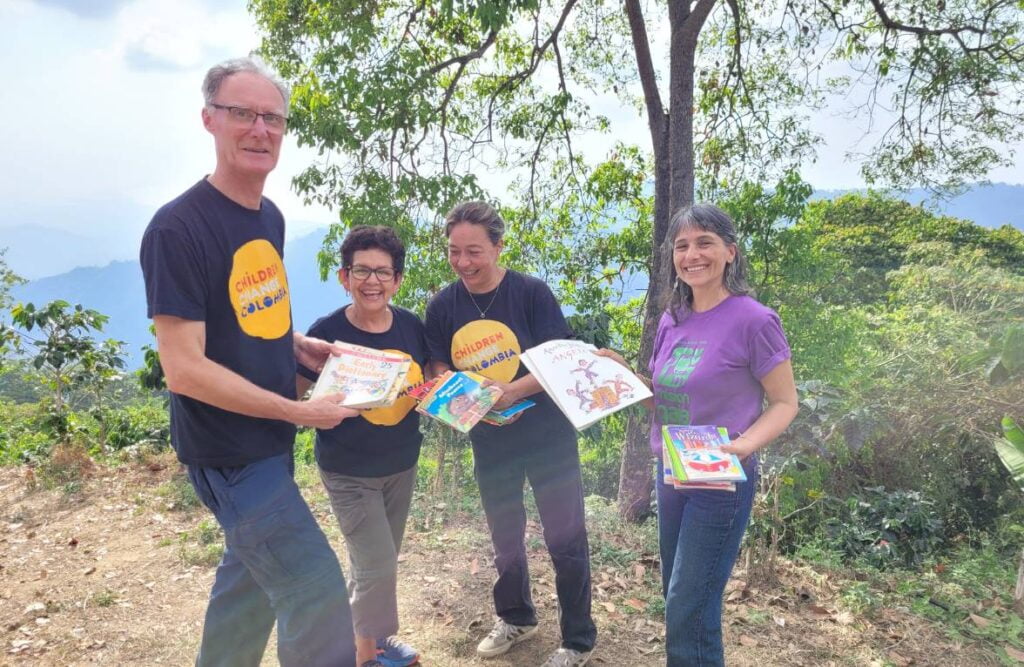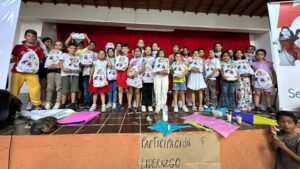In the heart of Colombia’s conflict-affected regions, where environmental degradation intertwines with social hardship, stories emerge that illustrate the profound intersection of peacebuilding and environmental initiatives. This particular story takes place in Minca, nestled in the Sierra Nevada de Santa Marta, and the surrounding territory, where Children Change Colombia, in collaboration with Misión Gaia, seeks to build peacebuilding frameworks through the pursuit of environmental conservation.
The region boasts a remarkable variety of ecosystems, from lush tropical rainforests to cascading waterfalls and crystal-clear rivers. Within this diverse environment, an abundance of flora and fauna thrive, including rare and endemic species found nowhere else on Earth. The Sierra Nevada is not only a sanctuary for biodiversity but also a melting pot of cultures and traditions. The region’s history is deeply intertwined with the indigenous communities that have inhabited it for centuries, each contributing to its vibrant tapestry of customs and beliefs.

The ambition
Children Change Colombia and the Caribbean Project covers a lot of ground, reflecting the diverse and complex contexts of the schools the charity works in within Minca and the surrounding territory. They seek to address socioeconomic, cultural and environmental challenges within the urban and remote mountainous areas of the region. The target audiences are the students within these schools and their families. To address educational obstacles, these organisations seek to foster community engagement, social responsibility and skill development among students to improve socio-economic development within the communities.
Educational and environmental challenges
In the Sierra Nevada, children face numerous challenges that significantly impact their access to education. The region’s intricate geography, coupled with demographic diversity including indigenous, farmer, and migrant communities, presents unique cultural hurdles for students. Many children endure difficult journeys to school, trekking for hours through rugged terrain, often braving adverse weather conditions.
In the rural areas of Minca, where transportation options are limited, students must leave for home before the rains start to avoid impassable roads, resulting in missed classes and disrupted learning. Moreover, the delicate ecosystem of the schools is vulnerable to disruptions, as the absence of just one teacher or staff member, such as a cook, can bring operations to a halt. These challenges underscore the urgent need for interventions like those undertaken by Children Change Colombia and Misión Gaia, which strive to address educational disparities and create more resilient and inclusive learning environments in Minca.
The territory where the schools are situated faces numerous environmental challenges that impact the lives of its inhabitants. The region’s economy, predominantly reliant on coffee cultivation and a blossoming tourism industry, is characterised by extractive practices that prioritise profit over environmental protection. Additionally, the pervasive use of agrochemicals heightens environmental degradation, contaminating water sources and posing health risks to the local population. The mismanagement of wastewater further exacerbates these issues, threatening the delicate ecosystems in the area, such as the marshes of Santa Marta, which support thousands of fishermen’s livelihoods. The recent expansion of tourism and its lack of proper planning and control further intensifies these challenges. These environmental issues pose a significant threat to the well-being and livelihoods of the students and local communities of Minca, highlighting the pressing need for sustainable solutions.

Holistic education and community engagement
Within the schools Children Change Colombia supports, the activities done with students reflect a holistic approach to education and sustainable development. These activities include a wide range of experiences aimed at nurturing not only academic knowledge but also emotional, social, and environmental awareness. For instance, students engage in hands-on experiences like organic gardening and waste management initiatives.
One activity the children participate in is the practice of planting seeds and nurturing them into plants. Through this activity, children are entrusted with the responsibility of caring for their own seedbeds, watering them, and ensuring their growth. This sense of ownership fosters a deep connection with the environment and instils a sense of responsibility within the children. This activity teaches children the importance of patience, nurturing, and commitment. As they witness the fruits of their labour, they gain confidence in their abilities. Field trips and outdoor exploration also allow the students to immerse themselves in their surroundings, fostering a sense of appreciation and stewardship for the environment.
Moreover, artistic activities like painting and drawing are integrated into the curriculum to encourage creativity and self-expression. The curriculum also incorporates discussions and reflections on topics such as community, empathy, and respect, promoting values that are essential for building a harmonious and sustainable society. The organisations collaborate with local businesses to start vocational training programs for the students that promote sustainable economic activities as well. Through these activities, they ensure that students receive a well-rounded education that empowers them to become environmentally conscious and socially responsible individuals. By improving community capacities and encouraging active participation, Misión Gaia in collaboration with Children Change Colombia is playing the foundation for a resilient and environmentally conscious society in Minca.
Fostering peace in a complex socio-political context
The territory in which the schools operate not only faces environmental threats but also the challenges of the nation’s decades-long internal conflict, which has caused social fragmentation and institutional neglect. The lack of sturdy institutions with the goal of promoting non-violent processes does not improve the situation, creating an atmosphere of distrust in the state. Intrafamily violence is also a significant issue, exacerbated by factors such as young motherhood and limited psychosocial support. Additionally, marginalised groups such as displaced persons and migrants face significant barriers to integration, creating social tensions and hindering community cohesion. In this complex socio-political context, fostering peace is crucial, and one of the most effective approaches is through promoting environmental consciousness.
Within the three schools CCC supports, the teachers from Children Change Colombia do more than teaching lessons. They are architects of kindness and compassion, helping the children embrace empathy for each other and the environment. This transformation has an impact beyond the classroom, permeating entire communities. In environments where armed conflict is embedded in daily life, the organisation’s educators understand the profound influence they wield.
By nurturing love and respect within the classroom, they offer a counterbalance to the harsh realities outside. For instance, instead of scolding a child for being disruptive, the teacher adopts a more empathetic approach. They enquire about the reasons behind their behaviour, asking questions like: “What is troubling you? How are you feeling? Why did you choose to behave this way?” Then the teacher explains why their actions are inappropriate so they understand the consequences. Through gentle guidance and understanding, they instil values of respect and cooperation, fostering a culture of peace from the ground up. Families, observing the positive changes in their children, can learn to reassess their own attitudes and behaviours, leading to a ripple effect of compassion and understanding.
As children learn to cherish and protect their surroundings, they also cultivate a deeper sense of stewardship for the environment. This holistic approach not only improves environmental sustainability but also nurtures emotional well-being and community cohesion. By planting seeds of kindness, Mission Gaia and Children Change Colombia’s teachers cultivate a future where love, respect, and environmental stewardship intertwine to create flourishing communities.

Sustainable peacebuilding and CBNRM
These initiatives to promote sustainable development and environmental education in Minca are real-world examples of the theories of sustainable peacebuilding and community-based natural resource management (CBNRM). According to Krampe et al. (2021), sustainable peacebuilding is the sustainable management of natural resources to support conflict prevention, resolution and recovery.
By providing community empowerment and traditional ecological knowledge, these organisations follow the principles of CBNRM as detailed by Milupi et al. (2017). The implementation of initiatives like waste management and vocational training allows communities to take ownership of their natural resources and participate in their management. This work thus shows how environmental cooperation can improve peacebuilding and contribute to sustainable development in conflict-affected regions, aligning with the frameworks of sustainable peacebuilding and CBNRM.
Additionally, Children Change Colombia has launched a new peace-building project called “Paz a la Mochila” that promotes this approach. In May 2024, around 20 leaders and teachers of the area will be trained on educational methodologies to discuss peace and no repetition with the children of the area.
Bridging peace and nature
Misión Gaia and Children Change Colombia’s initiatives highlight the intersection of environmental awareness and peacebuilding in Colombia. By emphasising the interconnectedness of humanity and the land, the organisation advocates for the conservation of the Sierra Nevada, recognising its importance for the environment and community well-being. Through education programs integrating psychosocial support, emotional intelligence sessions, and leadership workshops, these organisations nurture a culture of empathy, dialogue, and non-violence. This empowers individuals, particularly children, to become catalysts for positive change.
References
Barquet, K. (2015). “Yes to Peace”? Environmental peacemaking and transboundary conservation in Central America. Geoforum, 63, 14-24.
Black, R., Busby, J., Dabelko, G. D., De Coning, C., Maalim, H., McAllister, C., … & Staudenmann, J. A. (2022). Environment of peace: Security in a new era of risk.
Brock, L. (1991). Peace through parks: the environment on the peace research agenda. Journal of peace research, 28(4), 407-423.
Dresse, A., Fischhendler, I., Nielsen, J. Ø., & Zikos, D. (2019). Environmental peacebuilding: Towards a theoretical framework. Cooperation and Conflict, 54(1), 99-119.
Ide, T., Bruch, C., Carius, A., Conca, K., Dabelko, G. D., Matthew, R., & Weinthal, E. (2021). The past and future (s) of environmental peacebuilding. International Affairs, 97(1), 1-16.
Krampe, F., Hegazi, F., & VanDeveer, S. D. (2021). Sustaining peace through better resource governance: Three potential mechanisms for environmental peacebuilding. World Development, 144, 105508.
Milupi, I. D., Somers, M. J., & Ferguson, J. W. H. (2017). A review of community-based natural resource management.
Morales, L. (2017). Peace and environmental protection in Colombia. Proposals for Sustainable Rural Development. Inter-American Dialogue.





